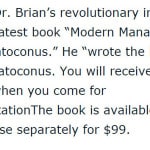INTACS PROCEDURE FOR KERATOCONUS, Since 1999
Keratoconus is more common now than ever before. Once thought to occur in 1 in 2000 people, Keratoconus is now 1 in 500 people.
Dr. Brian pioneered Intacs for Keratoconus and was the first surgeon in the world (except for France) to do this procedure for Keratoconus in 1999. He’ll typically perform more Intacs procedures in a single week than a number of surgeons will perform in a whole year.
Intacs placement is typically a quick, non-laser procedure that can correct mild to moderate nearsightedness and improve keratoconus. Intacs can be inserted by Dr. Brian at his Beverly Hills practice. Patients from Beverly Hills, Southern California and all over the country have visited Dr Brian’s office in Beverly Hills for his typically 10- minute Intacs procedure.
Intacs are clear inserts designed to reshape the cornea to correct vision. They are made of a material that has been safely used in contact lenses and cataract surgery for over 50 years. Intacs cannot typically be felt nor seen as they remain below the surface of the cornea. The procedure does not require any needles or shots, only numbing drops.
Intacs are now FDA-approved for keratoconus. The FDA in part adopted Dr. Brian’s procedure guidelines for the approved surgical technique which is the basis for instructional courses used to train other surgeons. Benefit of Intacs is potential for improved vision and risk potential is infection, inflammation, and glare among others. That is the reason Dr. Brian and every staff member here are all highly “detail-oriented” about every step of the process for every patient.
Surgical technique is very important as there are many different possible ways of placing Intacs along with many different sizes of Intacs to select. If Intacs are not positioned at the correct angle or the wrong type of sizes are used, it is possible to experience worse vision. For more details about this possibility, click here and read this important article.
Patients fly from all over the country for Dr. Brian to treat them. Your eyes are very precious. If another eye surgeon has offered to perform Intacs on you, you may want to ask about experience and does the surgeon know how to plan the Intacs surgery or does your surgeon have to send your information to outside consultant to be told how to do the Intacs procedure?
Specifically ask your surgeon 1) if 1 or 2 segments will be used, 2) what thickness will be used, and 3) what location will Intacs be placed? You will have an idea about level of experience with answers to those questions, especially if your surgeon needs to send your information to an outside consultant for advice. Dr. Brian has been doing Intacs for keratoconus over 10 years, which is longer than any other eye surgeon in the world (except for France where Dr. Joseph Colin was the first).
With Dr. Brian’s custom technique, you can be certain that safety measures have been addressed.
| EVALUATIONS | POTENTIAL BENEFIT to PATIENT |
| Intacs are exchangeable and removable | Accommodate future vision needs |
| Separate sterile equipment for each eye | Reduce risk of infection |
| Infrared pupil measuring equipment | Determine glare and halo risk |
After FDA approval in 1999, Dr. Brian was the first in the United States to publish the use of Intacs for treating a corneal degenerative condition called keratoconus. Since then, Intacs has dramatically increased in use for this condition world-wide as a result of his pioneering work. More detailed information can be found at www.KeratoconusInserts.com.
 |
CHART REVIEW AND CONSULTATION FOR OUT-OF-TOWN PATIENTS
Many out-of-town patients would like Dr. Brian to do a complimentary review of their medical records and make a preliminary determination of candidacy. This is useful before planning a trip to Beverly Hills. These are the easy steps:
Along with your last 2 or 3 eye exams, please be sure to include a color copy of your corneal mapping. Color corneal mapping is a very important tool, along with your exam history, to determine your candidacy. The last 2 years of your total eye history will be used to make this preliminary determination.
Inside the envelope, please be sure to include a cover sheet with your name address, phone number and email address and the words, “Keratoconus Record Review”, so that we may optimize communication with you.
Enclose with your letter a copy of your records.
Mail to:
Boxer Wachler Vision Institute
Keratoconus Record Review
465 N. Roxbury Drive, Suite 902
Beverly Hills, CA 90210
Dr. Brian will review and staff will contact you to discuss the review.


